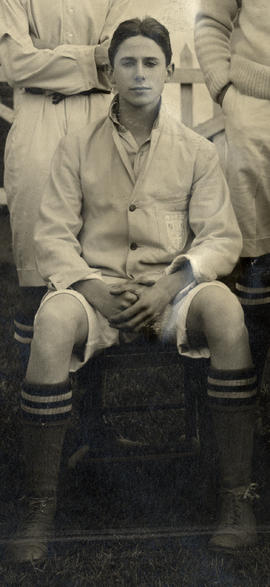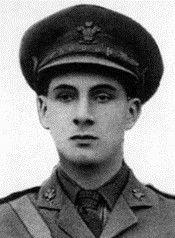Clark, Adrian John, son of Matthew Clark, of South Kensington, by Blanche, daughter of Charles Stuart Leslie; b. April 9, 1889; adm. Sept. 24, 1903 (A); K.S. (non-resident) Jan. 1905; left July 1906; LL. B. (London Univ.) 1910; called to the bar at the Inner Temple June 8, 1910; S. E. Circuit and Central Crirp. Court; Major 23rd Batt. London Regt. March 21, 1918; served in France with his regiment and as D. A. A. G., 3rd Army; mentioned in despatches L. G. Jan. 4, 1917; O. B. E. June 3, 1919; Stipendiary Magistrate, Trinidad, 1924-7; Judge of the High Court, Jamaica, 1927-34; Deputy Public Prosecutor, Singapore, 1934-6: puisne judge, Straits Settlements, 1936-7; legal adviser Federated Malay States 1937; m. June 12, 1929, Marguerite Muriel, daughter of John Charles Brooks, of Virginia Water; d. of dysentery in the Secret Police Prison, Singapore, whilst interned by the Japanese, March 11, 1944.
Adrian John Clark was born in London on the 9th of April 1889 the son of Mateo Clark, a railway contractor, and Blanche (nee Leslie) Clark of 128, Coleherne Court, Old Brompton Road, South Kensington. He was educated at Westminster School where he was a King’s Scholar and was up Ashburnham from the 24th of September 1903 to July 1906. He and was non resident from January 1905 and was a member of the Westminster School Cadet Corps until 1906. He was a member of the Fencing team in 1906 and competed in the Public Schools Events on the 6th of April that year. He won the School Sabre Competition in the same year. He went on to London University where he read Law and graduated LLb in 1910. He was called to the Bar in the Inner Temple on the 8th of June 1910 and worked in the South East Circuit and Central Criminal Court from chambers at 3, Temple Gardens, Temple.
He applied for a commission in the 23rd (County of London) Battalion, London Regiment on the 9th of January 1909. At a medical examination it was recorded that he was six feet and one half inches tall. He was commissioned as a 2nd Lieutenant in the Battalion on the 20th of January 1909 and was promoted to Lieutenant on the 4th of March 1910. He was promoted to Captain on the 20th of March 1911.
He was mobilised on the outbreak of war and went with the Battalion to St Albans where he volunteered for overseas service on the 26th of August 1914. He embarked for service in France with the 1/23rd Battalion of his Regiment at Southampton on board the SS Copenhagen at 7pm on the 14th of March 1915 and landed at Le Havre at 8am the following morning.
On the 2nd of May 1915 the Battalion was in billets at Le Touret when Adrian Clark was admitted to hospital with septicaemia. He was embarked on board a hospital ship at Boulogne on the 8th of May and landed at Dover later on the same day. He returned to the Battalion and went on leave on the 19th of December 1915, boarding the SS Archangel at Le Havre the next day and landed at Southampton on the 21st of December. He returned from leave on the 27th of December 1915. On the 4th of November 1916, the 1/23rd Battalion entered support trenches at Belgian Chateau in the Hill 60 Sector in the Ypres salient. During this time Adrian Clark suffered a blow to the left eye and he returned to England on the 7th of November where he was admitted to Queen Alexandra’s Hospital, Millbank on the 13th of November. He attended a Medical Board, which was held at the War Office on the 30th of January 1917, where he was declared as being fit for general service.
He was Mentioned in Despatches, which was announced in the London Gazette of the 4th of January 1917.
He was appointed as a Deputy Assistant Adjutant General for the 3rd Army on the 6th of February 1917 and was promoted to Major on the 21st of March 1918. He later served as a Lieutenant Colonel in the Royal Air Force. He was awarded the Order of the British Empire in the King’s Birthday Honours List of the 3rd of June 1919. He was demobilised on the 2nd of May 1919 and resigned his commission on the 30th of September 1921.
On leaving the army he served as a Stipendiary Magistrate in Trinidad from 1924 to 1927 and as a Judge in the High Court of Jamaica from 1927 to 1934. He was married on the 12th of June 1929 to Marguerite Murial (nee Brooks), later of Burleigh House, Brimscombe in Gloucestershire. He served as Deputy Public Prosecutor at Singapore from the 11th of September 1934 to 1936 and for the Straits Settlements from 1936 to 1937. In 1937 he was appointed as Legal Adviser to the Federated Malay States and worked from the Legal Advisers Chambers at Kuala Lumpur. He also served as a Major in the Selangor Local Defence Corps.
He was captured by the Japanese at the fall of Singapore on the 15th of February 1942 and was interned at Changi Barracks. Just after dawn on the 10th of October 1943, all of the internees at Changi were paraded for a roll call. A short time later Japanese Military Police, the Kempei tai, arrived and called out the names of fifty seven internees who were labelled and segregated. Three of these were women. A search of the of the barracks was carried out with the belongings of all internees being searched for radio telephony equipment which the Japanese believed was being used to contact people in Singapore to incite sabotage and anti Japanese activities outside the camp. Throughout the search the internees were made to stand in the sun without food or water until it was concluded at 6pm when they were allowed to return to the prison. The fifty seven men who had been separated were then taken to the Kempei tai Centre in Singapore for interrogation. They were detained in small cells or cages where they were given no bedding and with bright overhead lights burning throughout the night. From 8am to 10pm they were forced to sit up straight on the floor and were not allowed to move other than to use the toilets. The prisoners were beaten and tortured throughout their internment and on some occasions were told that they were to be executed. Adrian Clark died from dysentery at the Kempei tai Prison, Singapore. He was one of fifteen internees who died during the Double Tenth Incident.
Those who died were: -
Dr Cuthbert Arthur Stanley (Malayan Medical Service) Died 1st December 1943
S. Cornelius
A. Buchanan
William Lyle Stevenson Died 26th January 1944
Dermot Victor Prittie Perry (Medical Auxiliary Unit) Died 21st September 1944
Hilary Cameron Russell Rendle (Malayan Civil Service) Died 26th October 1944
Major Adrian John Clark, (Legal Adviser to the Federated Malay States) Died 21st March 1944
Norman Coulson Died 17th July 1944 (King’s Commendation for Brave Conduct)
S.A. Hagger
Henry Eardley Wilmot Bryning Died 1st February 1944
Stanley Musgrave Middebrook (Malayan Civil Service) Died 19th October 1944
John Herbert Bowyer (Chief Medical Officer, General Hospital, Singapore) Died 1st November 1944
Hugh Fraser (Malayan Civil Service) Died 25th July 1944
Wolfram Hermann Albert Penseler Died 2nd November 1944
Alan Wemyss Wellwood Ker (Director of Air Raid Precautions, Singapore) Died 25th September 1944
A trial of the Japanese participants in the Double Tenth Incident began on the 18th of March 1946 and was concluded on the 15th of April, with the death sentence being passed on eight members of the Kempei tai with life sentences passed on three more. Three more received sentences of between 8 and 15 years and six others were acquitted. Their commander, Lieutenant Colonel Haruzo Sumida, was hanged.
Clark is buried at Kranji War Cemetery Plot 35, Row G, Grave 13.

